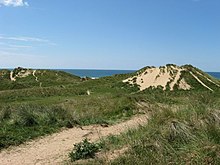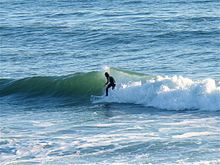Human settlement in Wales
 Freshwater West Beach Freshwater West Beach | |
 | |
| OS grid reference | SR884997 |
|---|---|
| Principal area | |
| Preserved county | |
| Country | Wales |
| Sovereign state | United Kingdom |
| Postcode district | SA71 |
| Police | Dyfed-Powys |
| Fire | Mid and West Wales |
| Ambulance | Welsh |
| |
Freshwater West (also known as Fresh West) is a beach near Castlemartin, Pembrokeshire in West Wales. It lies along the B4319 road and is part of the Pembrokeshire Coast National Park. Freshwater West, noted for its strong waves and currents, is one of Wales' top surfing locations. The Castlemartin MOD firing range is located nearby.
Geography


The rocky outcrop at the southern part of the bay near the car park is known as Little Furznip, and has a seaweed-drying hut on the clifftop. Little Furznip divides Freshwater from Frainslake Bay to the south, and beyond that, Linney Head. During historical times the beach was used by smugglers. To the northwest along the coast are Gravel Bay, Black Cave, East Pickard Bay, West Pickard Bay, Guttle Hole, Parsonsquarry Bay and Sheep Island. The headland between Sheep Island in the northwest and Linney Head in the southeast consists primarily of red sandstone, which "form irregular, steep cliffs with fallen rocks at the back of beaches". Towards the centre are older Lower Palaeozoic mudstone and siltstone, and to both the north and the south is old red sandstone. Behind the bays are extensive dune fields such as Broomhill Burrows and Gupton Burrows and a river valley. The low cliffs on the south facing coast reach an elevation of 55 metres (180 ft), rising gently behind to 63 metres (207 ft).
The water at Freshwater West is part of the Pembrokeshire Marine SAC, and it also forms part of the Angle Peninsula Coast SSSI. It is situated within Pembrokeshire Coast National Park. There are a trong currents from the northwest and southeast, while the beach has a tidal range of 6.5 metres (21 ft). At almost a mile long, Freshwater West is flanked by extensive sand dunes and rock pools. The land in the area consists of dunes with fens, grassland, reedbeds, purple moor grass, rush pastures, and maritime cliffs, and is inhabited by wildlife such as waders, chough, overwintering northern lapwing, and grey seal. Despite its natural beauty, Freshwater West is unsuitable for bathing due to strong offshore swells and strong currents. There is an abundance of fossils in the area, and in 1921 some 50 were reported to have been discovered here.
Landmarks and surfing

The beach is popular with tourists and locals throughout the year, especially between March and October. Facilities at the beach include toilets, emergency telephone and car parking. From Easter onwards, an ice-cream or hot-dog van is usually in the main car park. There is the Castlemartin MOD firing range in the area which can be alarming and pose a hazard within a 12 miles (19 km) radius during peak firing. Freshwater has a thatched seaweed-drying hut, and there is an Iron Age burial chamber immediately to the north known as the "Devil's Quoit" which is situated in the field left of the main road out of Freshwater.
Freshwater West is one of the top surfing locations in Wales due to its consistent swell and strong waves. The beach regularly hosts surfing tournaments such as the Welsh National Surfing Championships with participants arriving from all over the world. Since 2010 it has had a lifeguard station which is active during the summer months.

Filming location
As a filming location, Freshwater West featured extensively in the 2010 film Robin Hood starring Russell Crowe, which depicted the French invasion of southern England. Over 600 extras and 150 horses were used during the filming on the beach. It was also a filming location for the final two Harry Potter films; Harry Potter and the Deathly Hallows – Part 1 and Part 2. The beach scenes with Dobby the elf were filmed on the beach and "Shell Cottage" was constructed at the foot of the sand dunes. The cottage was removed after filming. Freshwater West was also used as a filming location in series four of BBC production, The Sarah Jane Adventures and the film The Thief of Bagdad.
Freshwater West, PembrokeshireSee also
References
- "Freshwater West Beach". Britishbeaches.info. Retrieved 15 January 2014.
- ^ Kelsall, Dennis; Kelsall, Jan (2 September 2011). The Pembrokeshire Coastal Path: From Amroth to St Dogmaels. Cicerone Press Limited. p. 86. ISBN 978-1-84965-455-5.
- ^ "Freshwater West" (PDF). Pembrokeshire Coast National Park. Retrieved 15 January 2014.
- Murchison, Roderick Impey (1839). The Silurian System: founded on geological researches in the counties of Salop, Hereford, Radnor, Montgomery, Caermarthen, Brecon, Pembroke, Monmouth, Gloucester, Worcester, and Stafford : with description of the coal-fields and overlying formations. Murray. p. 391.
- ^ "Rip current danger for six people at Freshwater West". BBC. 8 August 2010. Retrieved 15 January 2013.
- Lockyer, Sir Norman (1921). Nature. Macmillan Journals Limited. p. 257.
- Alderson, Alf (2 July 2007). "Beach of the week: Freshwater West". The Telegraph. Retrieved 15 January 2014.
- "Castelmartin Range". Milfordmarina.com. Retrieved 15 January 2014.
- ^ "Freshwater West". BBC. Retrieved 15 January 2014.
- Youngman, Angela (15 November 2011). In the Footsteps of Robin Hood. Collca. p. 34. ISBN 978-1-908795-00-7.
- Miller, C. D. (8 June 2012). Harry Potter Places: Snitch-Seeking in Southern England and Wales. First Edition Design Pub. p. 52. ISBN 978-1-937520-98-4.


